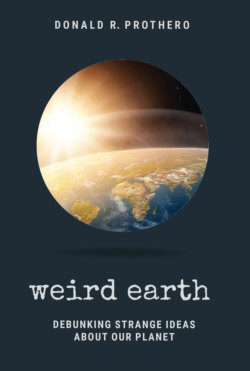Читать книгу Weird Earth - Donald R. Prothero - Страница 8
На сайте Литреса книга снята с продажи.
ОглавлениеPREFACE
Having written a book debunking UFOs and aliens (UFOs, Chemtrails, and Aliens: What Science Says, 2017, with Timothy Callahan) and also a book about cryptozoology (Bigfoot, Nessie, the Yeti, etc.) titled Abominable Science (2013, with Daniel Loxton), it occurred to me that there needed to be another book about the huge number of weird, paranormal, and supernatural ideas people hold about the earth. They range from crank ideas about geology (hollow earth, flat earth, geocentrism, moon-landing hoaxes, expanding earth, myths about the earth’s magnetic field), to mystical and paranormal explanations of earth features (aliens at Mount Shasta, ley lines, Atlantis, Lemuria), to mystical and nonsensical ideas about natural objects and processes (crystal healing, dowsing). As a professional geologist with forty years of experience teaching college geology, I have a broad background in many topics in the earth sciences, so I can discuss the reasons why these weird ideas are not real.
Since 2011, I have been writing almost-weekly blog posts on www.skepticblog.org about a wide variety of topics in science and skepticism, and I have often found myself addressing popular nonsense about the earth. I thought it would be a good idea to collect all these weird ideas into a book so that their common background and threads could be examined.
Thus, this book covers most of the weird ideas that have been promoted concerning our planet, especially the major ones like flat-earth beliefs, geocentrism, expanding earth, hollow earth, and the myths propagated by the Young-Earth Creationists. In addition, it covers some of the minor ones that most people haven’t heard of but that are popular in the paranormal and New Age communities of believers, such as the aliens in Mount Shasta, ley lines, and crystal healing. In addition to these individual topics, the first chapter provides a background to how science works and how scientists think so that we can better understand why science rejects these weird ideas. And the last chapter looks at the psychology of why people believe these weird things and what it implies for our future.
Of course, this book could be twice as long if I included nearly every topic that touches the earth in some way. There are lots of weird ideas about the weather (such as UFO clouds and chemtrails) that I have covered elsewhere, as well as auroras, ball lightning, the Tunguska explosion, and even conspiracies about humans controlling the weather, but these are largely outside the domain of geology. There are myths about aliens producing features on the landscape or creating crop circles, the Planet X/Nibiru idea, but those are largely covered in my book on UFOs and aliens.
Then there is the entire domain of apocalyptic beliefs and legends, and wild ideas about the end of the world, but debunking these is largely the domain of deconstructing religious prophecies and mistranslations of ancient Mayan inscriptions (as in the supposed end of the world back in 2000). These are not really about geology. Whenever these end-of-the-world scenarios mention actual geologic events, it’s just a mishmash of all sorts of natural disasters (earthquakes, tsunamis, volcanoes, floods, storms) thrown together as a mechanism to end the world, not a serious misunderstanding of how these processes work.
In many of the chapters, I’ve tried to go beyond just debunking the claims and have added a section called “How Do We Know?” that outlines the scientific evidence for why science rejects the ideas in this book as crackpot and wrong. I feel that this is one of the most important things that a reader can take away from a book like this: not only knowing what is false but also understanding why we know it is false. Otherwise, much of what people learn about science is just memorizing facts and dogmatic assertions (a common problem in our K–12 science educations); as a result, students (and readers of this book) don’t understand or even hear the huge amount of evidence for why science rejects some ideas and accepts others. I hope readers will realize and appreciate that this is the most important thing they can learn from a book like this.
